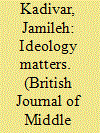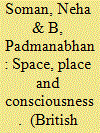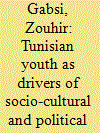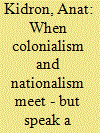|
|
|
Sort Order |
|
|
|
Items / Page
|
|
|
|
|
|
|
| Srl | Item |
| 1 |
ID:
187000


|
|
|
|
|
| Summary/Abstract |
Using feminist anthropology and interview data, this article investigates the gendered dimension of hunger striking in Israeli prisons. It draws on other cases from Ireland to the United States to explore the gendered nature of resistance to political imprisonment. I argue that women hunger strikers are active participants who weaponize their lives to resist the Israeli matrix of power and patriarchal societal norms. There have been less women in number when compared to male prisoners, but women have been more effective in collectively coordinating their pioneering action. Through necroresistance (transforming their body to a site of resistance) and the strategy of sumud (Arabic for ‘steadfastness’), women prisoners practice a dual resistance of the colonial authorities and the patriarchal society — simultaneously reclaiming ownership of their bodies and lives from both systems. This does not entail constituting their bodies as masculine (or de-feminizing themselves) so they are protected from sexual abuse. Rather, they insist on feminizing their experience and challenging gendered stereotypes of women as ‘victims’ with ‘fragile bodies’. For them, gender is not a barrier but a motivational factor in which self-sacrifice to protest injustice is far superior to enduring the wrongs of political imprisonment.
|
|
|
|
|
|
|
|
|
|
|
|
|
|
|
|
| 2 |
ID:
187009


|
|
|
|
|
| Summary/Abstract |
Since its inception, Daesh has been regarded as a powerful actor by pundits, journalists, and politicians. This paper’s primary aim is to show how, and by what cultural means, Daesh became so powerful, and to study what lies behind its non-coercive power. This paper is part of an ongoing research project designed to study the different aspects of Daesh’s power. Drawing on Gramsci’s ‘hegemonic power,’ and Bourdieu’s ‘cultural capital’, the research explains what it is in Daesh’s cultural power that creates consent. In doing so, this study examines the various English and Arabic content of Daesh’s official media and the documents it has released since June 2014. Additionally, data has been collected from 19 semi-structured expert interviews together with other secondary sources. The findings of the study show that Daesh’s power goes beyond its coercive power. This research acknowledges that Daesh’s ideology is central to its power and is present in all aspects of the Khilafah’s activities, including in its multi-faceted power (i.e., its cultural, media, political and economic power).
|
|
|
|
|
|
|
|
|
|
|
|
|
|
|
|
| 3 |
ID:
187007


|
|
|
|
|
| Summary/Abstract |
This article shows the different themes but also change of perspectives and approaches that Mernissi dealt with or underwent over the years. It examines the trajectory and impact of her arguments, especially from a critical standpoint. It sheds light on her religious approach and its bearing on Islamic and Moroccan feminisms. The latter approach does not explain the complexity of the link between women’s status and the socio-political context in a Muslim-majority country like Morocco, nor does it provide an answer to women’s problems and aspirations. Using the intersectionality theory, I claim that, to challenge patriarchy and foster gender equality and women’s empowerment, the alternative approach is to think beyond Islam, by arguing that Moroccan women’s roles are shaped by a variety of intersecting factors, namely post-colonial thinking, demographic change, nationalism, poverty, and the progressive shift to a modern society. Adopting the Universal Declaration of Human Rights and The Convention on the Elimination of All Forms of Discrimination against Women (CEDAW), first promulgated in 1979 by the UN General Assembly, and often described as an international bill of rights for women, is also part of this alternative human rights approach.
|
|
|
|
|
|
|
|
|
|
|
|
|
|
|
|
| 4 |
ID:
187005


|
|
|
|
|
| Summary/Abstract |
Most of the literature on gender and forced migration has focused on vulnerability, highlighting a lack of agency among refugee women during periods of displacement. This paper takes a different approach, exploring instead the factors that influence refugee women’s agency within contexts of adversity and vulnerability, through a small case study of Syrian refugee women in Amman, Jordan. It addresses gender, forced migration and economic empowerment using a womanist approach and a lens of intersectionality Semi-structured individual and focus group interviews were carried out with humanitarian professionals and economically active Syrian refugee women. Findings illustrate the many ways that these women manage their lives and build resilience in themselves, their families, and their communities, despite their displacement, using strategies which emanate from their collective cultural context rather than oppose it. Findings also highlight the space created by displacement which opens opportunities to Syrian refugee women, rather than only obstacles. We argue that the profession of social work is in a good position to take forward learning from the study to support these transformative processes.
|
|
|
|
|
|
|
|
|
|
|
|
|
|
|
|
| 5 |
ID:
187004


|
|
|
|
|
| Summary/Abstract |
Modern scholarship has largely neglected Abu’l-Raja’ Chachi Khumraki (d. c. 1124 C.E.), although he was well versed in Islamic jurisprudence and esoterism, not to mention his unique interest in classical Persian avian literature, which has not received serious, scholarly attention. To date, no study has discussed the significance of Chachi Khumraki’s bird symbolism. This essay focuses upon his conception of salvation in the Rawdat al-fariqayn (The Garden of the Two Schools)—a mysticojurisprudential manual on Islamic law and on Sufism—analyzing the author’s deployment of the motif of the Sīmurgh in the chapter entitled ‘The Ṣalāt al-khawf [Fear Prayer]’. Further, it argues that the Sīmurgh performs two major functions: First, it attempts to bring together two rivalrous Sunni schools of law, i.e. Hanafism and Shafi‘ism, in medieval Transoxania, and second, it warns against neglecting the inner dimension of Islam, i.e. taṣawwuf (Sufism). Whilst the author acknowledges the importance of practising fiqh, the Sīmurgh narrative attempts to draw the schools’ attention to the fact that the soul will attain salvation only if it eschews the shackles of the nafs al-ammārah bi’l-sū’ (the soul that commands to evil) by means of the teachings of Sufism.
|
|
|
|
|
|
|
|
|
|
|
|
|
|
|
|
| 6 |
ID:
187006


|
|
|
|
|
| Summary/Abstract |
The notion of space is central to Jewish civilization as it evolved over complex geography. Amos Oz, the prominent Israeli writer explores the continuity of cultural and spatial experiences of Jewish populace in the land of Israel. This paper focuses on interpreting Oz’s image of Israel and the psychological multiplicity of Jewish civilization in A Tale of Love and Darkness, his memoir of family saga and national history. Oz’s arguments regarding the collective Jewish consciousness in connection with the distributed geographical space is analysed as a chronotopic discourse. The memoir deconstructs Oz’s Sabra image attributed by the Zionist ideology and offers a post-modern dynamic narrative constructed well within the notions of time and space. A spatial reading of the memoir explores the existential ties between Jews and the land of Israel.
|
|
|
|
|
|
|
|
|
|
|
|
|
|
|
|
| 7 |
ID:
187002


|
|
|
|
|
| Summary/Abstract |
The prediction that the nation of Tunisia would initiate a walk towards democracy was not on anyone’s mind. In the context of two draconian regimes and a colonial past, the 2010 Arab Spring brought significant changes to Tunisia, observable mainly in freedom of expression and association. This helped to create and shape a space wherein Tunisians’ daily lives reflect the cultural juxtaposition of an Islamic heritage with a secular propensity. This paper examines the content of Tunisian cultural memory from youths’ perspectives on the past, cultural icons, and nostalgia. It argues that Tunisian youths’ disenchantment with the socio-political life in Tunisia and its impact on their feeling of belonging hinges on a sense of fracture or discontinuity in the nation’s cultural memory, considered the blueprint of Tunisianité or national identity. The paper demonstrates that despite youths’ hybrid culture, influenced by ‘globalization’ and ‘glocalization,’ the majority of surveyed youth value, inter alia, family life, and identify with the Islamic culture and religion. Tunisia’s youth may know little of their pre-colonial and post-colonial history, but Tunisians should reengage with their young constituency through education and a cultural memory that binds generations. This will ensure that the Tunisian culture does not absorb western values and ideals in the name of progress.
|
|
|
|
|
|
|
|
|
|
|
|
|
|
|
|
| 8 |
ID:
187003


|
|
|
|
|
| Summary/Abstract |
This paper addresses the convergence of British colonialism and Zionist aspirations in Mandatory Palestine. As research so far explored this topic mainly as a confluence of colonial-national interests, this paper is an attempt to look at it from another vantage point, based on the different interpretations of European Modernism and Orientalism by these two groups. The new variable is the Zionist perception of nationalism, and its ties to European Modernism, which strengthened Zionist autonomy in a way that countered British interests to some extent and strengthened Zionist advantages in Palestine over Arab society. These processes were particularly prominent in mixed cities. Haifa was central to this concept as it was free of historical or symbolic baggage. The British developed Haifa as a strategic economic centre, and as a modern space. Promoting unilateral national interests was the very opposite of the British intention for the city. Yet, they allowed and even encouraged Zionist entrepreneurs to create an autonomous national community. We contend that the British had a certain blindness to the symbolic significance that the Zionists attached to the process of urban development, not only as a Modern-European development process but as a basis for national autonomy.
|
|
|
|
|
|
|
|
|
|
|
|
|
|
|
|
| 9 |
ID:
187008


|
|
|
|
|
| Summary/Abstract |
This article presents a novel, tripartite division of three seemingly identical structure types in terms of their aspectual differences: who believed, who believe and the believers. The debate on these three structures (a relative pronoun followed by a verb in the past or in the present and the agentive noun) pits the opposing views of those who advocate for their similarity and congruence (Reuschel 1996), and those who firmly believe that phonemic or syntactic differences definitely bring about differences at various levels (Bloomfield 1933). The contexts, exegeses and the relationship between 438 utterance components are analysed here. The results help disentangle the tight knot of long-standing sameness of these three types of structures. The who believed type is shown to express shades of aspect such as a) the constancy of the occurrence of an action, b) progressive actions explored retrospectively in the future such as Judgement Day and c) an action that was completed in the past. The who believe type is shown to go hand in hand with habitual or iterative aspects. The believers type allows for greater flexibility to combine the first two.
|
|
|
|
|
|
|
|
|
|
|
|
|
|
|
|
| 10 |
ID:
187001


|
|
|
|
|
| Summary/Abstract |
Women academics confront obstacles in their professional lives. This paper explores the challenges that these women face in Jordanian higher education. The study adopts a social constructivist approach that integrates auto-ethnography and co-constructed storytelling techniques. This is primarily conducted to provide an insider’s view into the academic experiences of Jordanian women. Such methods allow for the development of social insights that may be traditionally hindered when using positivistic methodologies. The findings generated from the stories narrated by three academic women indicate challenges allied to their experiences, expectations, and gender. The findings show that the identified challenges are culturally bound and are attributed to Jordan’s Arabic patriarchal mindset. Women academics in this study are considered ‘determined’, as they successfully overcome significant impediments.
|
|
|
|
|
|
|
|
|
|
|
|
|
|
|
|
|
|
|
|
|